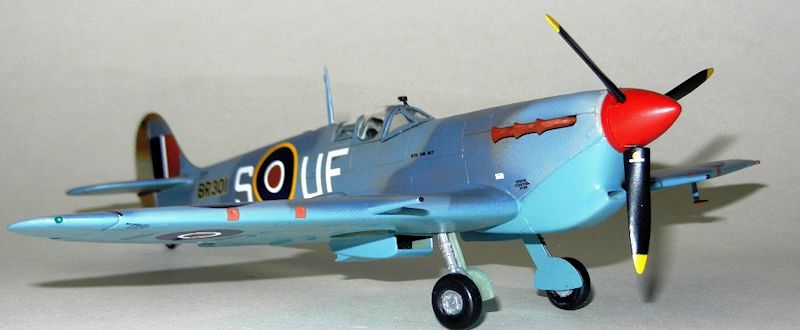
Airfix 1/48 Spitfire V/trop
| KIT #: | 05110 |
| PRICE: | CAN$30.00 |
| DECALS: | Two options |
| REVIEWER: | Pablo Calcaterra |
| NOTES: | Victory Productions 48006 decals |

| HISTORY |
George Buzz or Screwball Beurling was
born in Verdun, Quebec (Canada) on December 6th
1921.
Buzz lived to
fly. He’d do anything and everything to pile up flying hours. He would clean the
planes, fix them, help at the airport just to save every single dime and use the
money to take flying lessons. Ted Hogan and'' Fizzy " Champagne, prewar bush
pilots were his instructors.
He tried to join the RCAF but was
rejected due to his lack of formal education in an Air Force that was still too
small
to accept anyone else but the ones considered noting but the best.
When the Soviets
attacked Finland he tried to join the Finns but just before he had managed to do
so their resistance ended. He also smuggled himself to the US trying to catch a
ship to China to help them against the Japanese but was caught by the police and
returned to Canada.
Correctly
assessing that the hard pressed RAF would be more open to take him in he joined
a Merchant trip and traveled to England in U boat infested waters. First thing
he did when he got to Glasgow was to run to the closest RAF Recruitment Office.
Everything was going well until he was asked for his Birth Certificate…which he
had left back home. So back to the ship it was, across the Atlantic again, home
to pick up the paper, onto the ship once more and then to the same Recruitment
Office where the very same RAF officer was behind the desk!
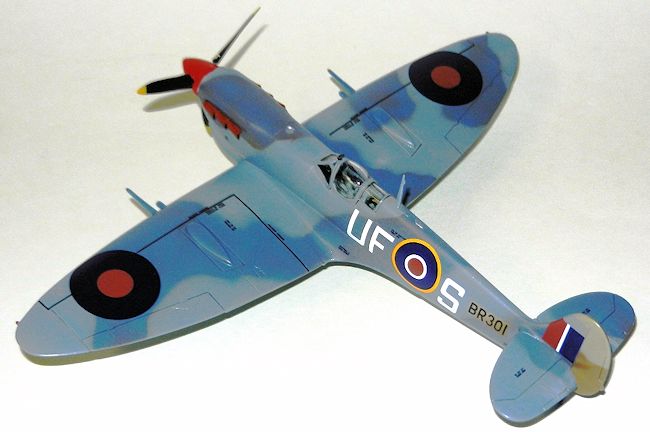 His
application was immediately accepted and George was finally able to join the RAF
on September 20th 1940 at the
height of the Battle of Britain.
His
application was immediately accepted and George was finally able to join the RAF
on September 20th 1940 at the
height of the Battle of Britain.
After almost a year of training (and
relearning things he already knew…probably better than his instructors) he was
given his wings on September 9th
1941. Life during training was not as exciting as he wanted and he got in
trouble more than enough hedgehopping, buzzing the airfield and even once diving
on the airfield Control Tower where a startled guard got so scared that jumped 2
stories to the ground to avoid getting hit by Beurling’s plane.
He initially
joined 403 RCAF Sqn as a Sergeant but his indiscipline and individuality added
to his eagerness to tackle the Germans gained him the cold shoulder from his
fellow squadron members.
George saw action
first when he was put in the Arse Tail Charlie position during a sweep over
France. Knowing that this was the most dangerous position he was extremely
alert. He was singled out by Focke Wulfs even though he had warned his Leader
that they were going to be bounced. He took off by himself, shot at a 190 using
such big deflection that his target did not show in the cinegun. Nevertheless,
the German was shot down. He managed to wriggled himself out of danger and
return to the base where he was reprimanded for leaving the Squadron, and even
more when he claimed a German shot down that was not showing in the film of his
Spit (just clouds)
The following
combat saw him in the same place and this time his plane was riddled and
seriously damaged. As a last resort and being followed by 6 Focke Wulfs he
climbed into the sun hoping they would lose him in the glare. They did and when
they overshoot George was able to shot down one of the Germans with his two only
working .303s from 50 ft away.
Not happy with
the amount of action and the lack of understanding of air combat knowledge that
he believed the rest had he volunteered to go to Malta trading places with
another pilot who did not want to go there because he was married.
As we all know
Malta is the place where George gained fame.
Malta – 1942
At the time the island was being
bombed constantly by the Italians and Germans. They outnumbered the British
Spitfires at times 10:1 or more. During one of the resupply of planes from HMS
Eagle George arrived in Malta on June 9th
to fly with 249 Sqn. As soon as he landed and had his plane moved to a blast pen
he was pushed out of the Spit, another pilot took his place, the plane was
loaded and refuelled and i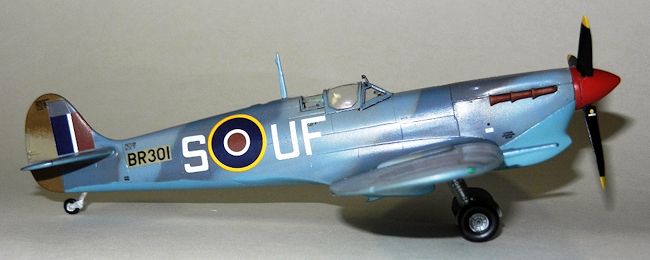 mmediately
took off. The Germans were attacking the airfields trying to catch the recently
arrived planes. In the ensuing dogfights over the island the plane in which
George arrived was shot down. This very well set the pace and he realized that
this was the place he had always wanted to be.
mmediately
took off. The Germans were attacking the airfields trying to catch the recently
arrived planes. In the ensuing dogfights over the island the plane in which
George arrived was shot down. This very well set the pace and he realized that
this was the place he had always wanted to be.
Pilots in the
island where flying up to 8 sorties per day! They were drained and also sick
with dysentery (called Malta dog) which eventually caught up with him weakening
him so much that he was unable to fly in spells of several days.
But at the same
time his training and self-preparation (as he mastered deflection shooting with
his own formulas and calculations) make an immediate mark in the air above the
island.
To give an idea
of his obsession with perfection and deflection on one occasion he hit a MC 202
with a few shots. As the plane flew away he believed that it had been damaged
but not critically. But critically damaged it was and the pilot (Sgt. Gelli)
made a forced landing in tiny Gozo island suffering injuries in the process.
When Screwball was told that his MC 202 had indeed been shot down he asked where
the plane had been hit. Upon learning that the bullets had not hit an area that
he had targeted and thought to have damaged he was disappointed. This only
increased his resolve to improve his skills.
During the time
on the ground he would take pot shots with his revolver to lizards to practice
deflection. He was also put corned beef on the floor and this would attract tens
of flies. When these where on the food he would very carefully lift his boot and
crush them at the same time exclaiming “The Screwballs!!” which earned him his
nickname.
Spitfire Vc
BR301
It was flown to Malta from HMS Eagle
on May 9th 1942 and assigned to 601
Sqn. 67 Spits were flown to Malta from USS Wasp (17) and HMS Eagle (50). The
planes arrived in the middle of a German raid and as soon as they had landed
their pilots were pulled out of their mounts, the planes rearmed and refuelled
and in some instances they were back in the air within minutes.
Victories for
this particular machine are as follows:
June 26th:
an attack by five Z1007bis of the Regia Aeronautica was heavily protected by
MC202 and RE2001. In response the RAF scrambled
six Spitfires from 601 Sqn (among them BR301) and 126
Sqn followed by ten more of 603 Sqn and eight of 185 Sqn. Pilot Officer McCurry
(US) claimed one Me109 shot down (in fact it was a MC202). Other claims include
two more 109s (again misidentified 202s) and a RE2001 shot down (for a total of
4 enemies show down and several others including bombers damaged). In turn the
Spitfire pilots suffered two seriously damaged planes while the Italian pilots
in fact lost only one MC202 shot down with the pilot killed (M.llo Runci) while
claiming 3 Spits shot down and one probably. In short the Italians got the upper
hand in terms of kills (2:1) while claiming less enemies shot down (3 against
4).
In July BR301 (UF-S) was transferred
to 249 Sqn.
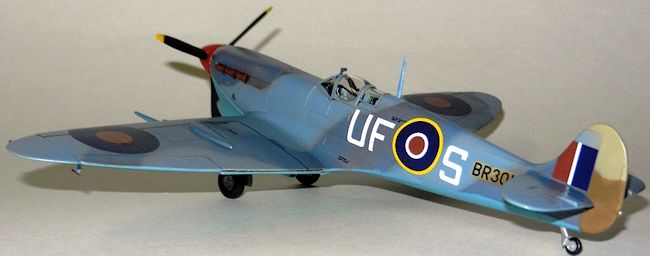 July 7th:
flown by Pilot Officer McElroy (RCAF) this particular Spit was credited with
another victory during a series of very violent combats that took place during
the morning when 12 JU88s escorted b y 24 Me109s and 30 MC202 bombed Luqa. The
British defence consisted of 12 Spitifres from 249 Sqn and 6 from 185 Sqn.
Claims for this combat were as follows: three 109s and one 202 (McElroy’s) shot
down but in turn the defenders lost 3 Spitfires (one by friendly AA). Axis
claims were 4 Spits shot down by the 109 pilots and one shared by two 202 pilots
(the pilot being seeing to climb out and bail out and matching the actual
events) in return for two 202 seriously damaged that managed to return to their
base. Again in this combat there was a great overclaiming by the Malta pilots
(no Axis plane shot down) while the Germans also overclaimed significantly with
the Italians being on the mark claiming only one.
July 7th:
flown by Pilot Officer McElroy (RCAF) this particular Spit was credited with
another victory during a series of very violent combats that took place during
the morning when 12 JU88s escorted b y 24 Me109s and 30 MC202 bombed Luqa. The
British defence consisted of 12 Spitifres from 249 Sqn and 6 from 185 Sqn.
Claims for this combat were as follows: three 109s and one 202 (McElroy’s) shot
down but in turn the defenders lost 3 Spitfires (one by friendly AA). Axis
claims were 4 Spits shot down by the 109 pilots and one shared by two 202 pilots
(the pilot being seeing to climb out and bail out and matching the actual
events) in return for two 202 seriously damaged that managed to return to their
base. Again in this combat there was a great overclaiming by the Malta pilots
(no Axis plane shot down) while the Germans also overclaimed significantly with
the Italians being on the mark claiming only one.
July 9th:
Takali was raided by seven JU88s escorted by Me109s and MC202s.
Spitfires from several squadrons took of to engage the raiders with P/O McElroy
claiming a shared JU88 destroyed (along with P/O Rae (NZ)). Again the defenders
suffered more losses than the Axis with 2 Spits shot down against one 202.
German pilots claimed 4 Spits destroyed and the Italians 3 seriously damaged
while the British claimed one 109 and one 202 with several probably destroyed.
No JU88 was reported lost in this raid.
July 11th:
a strong raid by 13 JU88 successfully escorted by masses of Axis fighters (47 in
total!) that prevented most of the twelve Spitfires from 249 Sqn from reaching
the bombers. In the exchange one 109 was shot down by F/L Daddo-Langlois with
the pilot captured and another one was claimed shared destroyed by P/O Yates
(RAAF) in BR301 and W/O Ramsay (but this claim does not match the actual Axis
losses).
July 13th:
Another strong attack by JU88s with many MC202, RE2001 and Me109s as escorts
developed during the morning. The Spit jockeys claimed three JU88 and one type
of each fighter (including a 109 by P/O McElroy in BR301) with several more
damaged. Actual Axis losses were only two 202 with their pilots killed. The
Italians claimed 2 Spitfires shot down and the Germans one more but none was
lost. Therefore there was a significant overclaiming on both sides.
July 27th:
on this date the team BR301 – Beurling claimed the first victories. After a raid
of JU88s bombed with no problem Malta the German lost their 109 escorts on their
return trip. By then the Spitfires including some from 249 Sqn arrived on the
scene and the MC202s went to the defense of the bombers. Beurling saw four MC202
and attacked them aggressively. First he tackled the #4 with deflection
shooting. The 378 Sqn MC202 flown by S/M Gelli went into a spin after being hit
in the engine and radiator and the pilot force landed in the island of Gozo.
Immediately Beurling went for his next Italian: Italian ace Capt. Furio Niclot
from 151 Sqn in his Mc202 had misinterpreted the signs from his wingman who was
warning him about the approaching Spits. When he looked in the direction of the
attack he found himself staring at the guns of Beurling’s plane. The Macchi
caught the full blast of the Spitfires armament. When the 202 exploded the
highly respected ace died instantly. Niclot It was a shattering loss for the
Italians as this casted doubts about the result of their fight: if Niclot had
bought it then anyone could be next. Seeing two 109s below
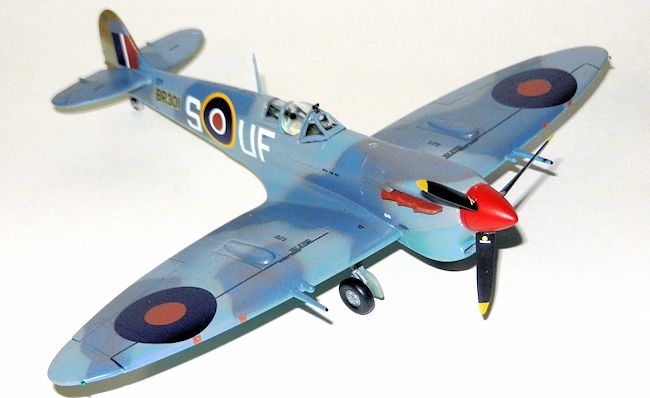 him
Beurling he dove towards them, climbed to their bellies, claimed one shot down
on fire and damaged the tail and wings of the second one who managed to escape.
Other Spitfire pilots claimed 2 more Me109s. It seems that in fact they had also
engaged Macchi 202 from 20 Gruppo who only had, besides Niclot, two planes
damaged with one pilot injured. One Me109 claimed (wrongly) a Spitfire kill and
there were no losses to the Germans in this combat. In summary we have 5 Axis
fighters claimed when in fact two were shot down and 2 damaged and 1 Spit
claimed downed when no losses were sustained.
him
Beurling he dove towards them, climbed to their bellies, claimed one shot down
on fire and damaged the tail and wings of the second one who managed to escape.
Other Spitfire pilots claimed 2 more Me109s. It seems that in fact they had also
engaged Macchi 202 from 20 Gruppo who only had, besides Niclot, two planes
damaged with one pilot injured. One Me109 claimed (wrongly) a Spitfire kill and
there were no losses to the Germans in this combat. In summary we have 5 Axis
fighters claimed when in fact two were shot down and 2 damaged and 1 Spit
claimed downed when no losses were sustained.
July 29th:
249 Sqn took off to intercept a raid of aprox 16 109s and 4 202s. The seven
Spitfires engaged their adversaries and Beurling’s Spit (BR301) was hit by a 109
that blew his canopy away. Recovering from the initial surprise he attacked the
plane he believed had damaged him and a short range aimed burst of cannon and
machine guns shot down the plane flown by K-H Witzchke of 3/JG77 who bailed out
but was killed when his parachute caught fire. Sgt. Budd’s Spitfire was heavily
damaged and he force landed in Malta having first shot down a Me109 (in fact it
was a Machi 202 whose pilot bailed out and was captured by the British). Two
claims were submitted by Me109s pilots (Geisshardt for his 86th
victory and Rollwage for his 28th).
Thus it can be seen that in this combat the claims were for once quite close to
reality (though Beurling’s plane was damaged and not shot down it seems that it
never flew again as it is not mentioned from that moment onwards on any combat)
Beurling kept on fighting without
respite and was finally shot down and wounded on October 14th.
His victor was either Obfw
Riker of 4/JG53 or Ltn Karl von Lieres of 2/JG27 (who was credited with his
26th). Of the seven Ju 88s claimed to have been shot down by the RAF in this
combat only one did not return. This was the end of his career in the island.
After recovering in hospital for 2 weeks he was sent back to the UK.
After a
nearly miraculously escape from the B-24 that was taking him along many of his
friends back to the UK (the plane crashed in the Mediterranean while trying to
land in Gibraltar) he was sent on a tour to and Canada (which greatly bored
him).
By mid 1943
he was posted as an gunnery instructor and on June 8th
he was accidentally shot at during a mock dogfight, bailing out of his Spitfire.
Finally his wish was granted and on September 1st
1943 he was transferred to the RCAF (403 Sqn) flying Spitfires IX. He shot down
a Fw 190 of JG2 in September but found the fighter sweeps annoying. He started
to have disciplinary issues again and his flying stunts on the Squadrons Tiger
Moth finally got him transferred to 412 Sqn. He claimed another Fw190 on
December
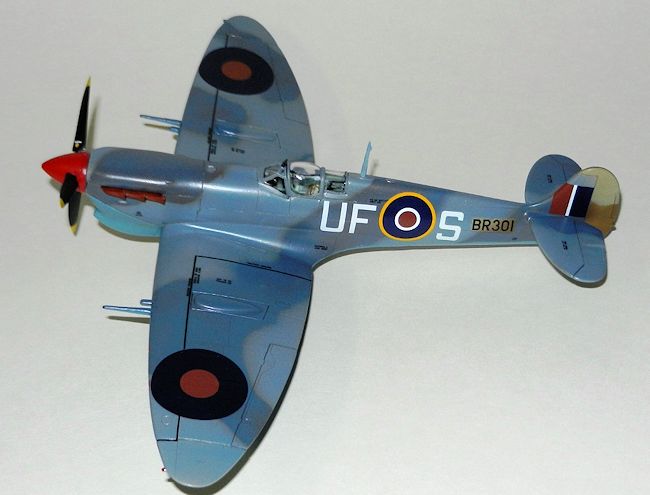 30th
1943 but the damage was done. He was not well liked here either due to his lack
of discipline and team work and finally he was sent back to Canada and given an
honourable discharge. His involvement in WWII was over.
30th
1943 but the damage was done. He was not well liked here either due to his lack
of discipline and team work and finally he was sent back to Canada and given an
honourable discharge. His involvement in WWII was over.
| THE KIT |
This the old Airfix Spitfire Vb
that was reissued a few years ago with parts to convert it into a Vc or a
Seafire. Basically what you get is exactly the same old kit with all the old
parts (raised panels) and a couple of spruces more that have the wings for the c
version plus parts for the Seafire (these on a different quality of plastic and
with recessed panel lines!)
| CONSTRUCTION |
As I decided not to have engraved
panels on the wings and raised on the rest of the plane I tackled the tedious
job of re scribing all the panel lines on the fuselage using
Dymo tape and a couple of hobby knifes. This was done before putting both
halves together. The newly engraved guide for the arrestor hook (Seafire) insert
has weakened the area so I almost made a passing hole while scribing the panels.
The interior of the cockpit was
painted with ModelMaster Acryl RAF Interior Green. The seat was painted with a
mix of red and brown to deliver the bakelite colour. Seat harnesses were made
with aluminum foil and painted in light brown (beige). These were passed behind
the pilot seat/bulkehead and supported with a piece of plastic. Instrument panel
and other details in the area were painted black with touches of aluminum to
represent wear.
Once the halves of the fuselage
were glued together I had to use some putty to fix some areas. The cap for the
gas tank in front of the windshield has the union of the two fuselage halves
very prominent. It is very hard to remove it using putty so what I did was to
add two or three layers of white glue until the gap between halves disappeared.
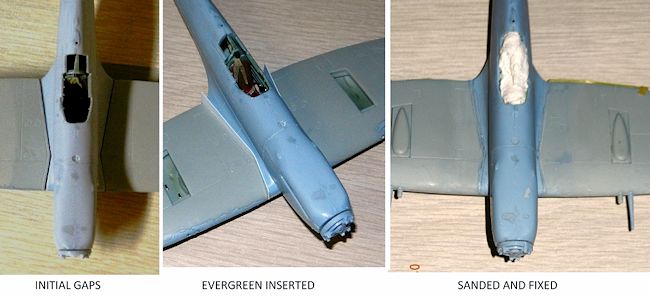 Now came
one of the most complicated parts of the build: attaching the wings for the C
version. As mentioned above, these are part of the new sprue, have engraved
lines and are made of a different plastic (both in texture and colour).
Now came
one of the most complicated parts of the build: attaching the wings for the C
version. As mentioned above, these are part of the new sprue, have engraved
lines and are made of a different plastic (both in texture and colour).
The fit of these wings leaves a lot
to be desired with a 1 mm gap at wing root and a very large gap in the union
below the fuselage in the trailing wing area. The central part of the bottom
half is not curved as it should and therefore it does not touch the opening at
the back of the fuselage.
I glued the wings structure firmly
securing it at the wing roots and front of the fuselage. This left the gaps
mentioned above.
The easiest part was to fix the
gaps on the top of the wing roots. Just added strips of Evergreen, sanded and
rescribed lines and it was done (easier said…)
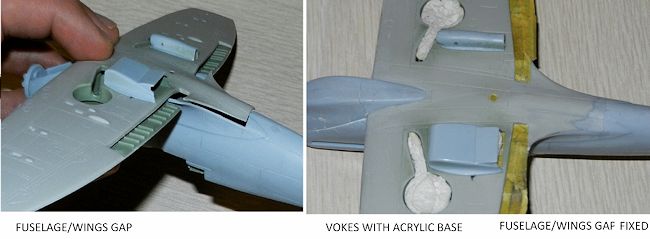 The
bottom of the fuselage was quite more complicated. It required a little bit of
plastic blending, lots of instant glue, followed by plastic glue. Once this was
dry I used copious amounts of putty and sandpaper to make the union smooth.
The
bottom of the fuselage was quite more complicated. It required a little bit of
plastic blending, lots of instant glue, followed by plastic glue. Once this was
dry I used copious amounts of putty and sandpaper to make the union smooth.
Radiator and oil cooler came from
the original version of the kit. Some rescribing of panels was made (to remove
the raised lines)
With the wings “under control” I
glued the wingtips (not a very good fit…some filler needed), the gun covers
(broad version chosen) and the external 20 mm guns (with the internal ones
removed and covered like in the case of this plane) This modification was made
in Malta to make the planes lighter.
Vokes filter attached (and again a nice gap that needed filling, in this case using acrylic paste that was wiped out flat using a damp cloth), underside light, cockpit, landing gear wells, the openings of the filter, oil cooler and radiator covered along with the internal side of the upper wing where the flaps fold into (the idea being to display the plane with the flaps dropped thanks to the addition of the internal ribs in the new wings supplied by Airfix…more about that later) and I was ready to start painting the Spit.
| COLORS & MARKINGS |
Spits supplied to Malta at this
moment of the fight were brown, sandstone and azure blue. Good for a desert
environment and good for Malta too had the air fighting had only taken place
JUST above the tiny island. But of course that was not the case and the
brown/sand planes stood out too clearly above the Med Sea. So then they were
hurriedly painted in the plane carriers with whatever paint was available.
There are lots of articles (and
debate) about the true colours that these planes were painted with. Apparently
there are several that were used, and to that there were also lots of hues and
paint density.
I have looked for the picture(s) based on which profiles of this
particular Spit were made but to no avail. So I have followed those profiles
(that sometimes don’t agree in some details among them due to the artist’s
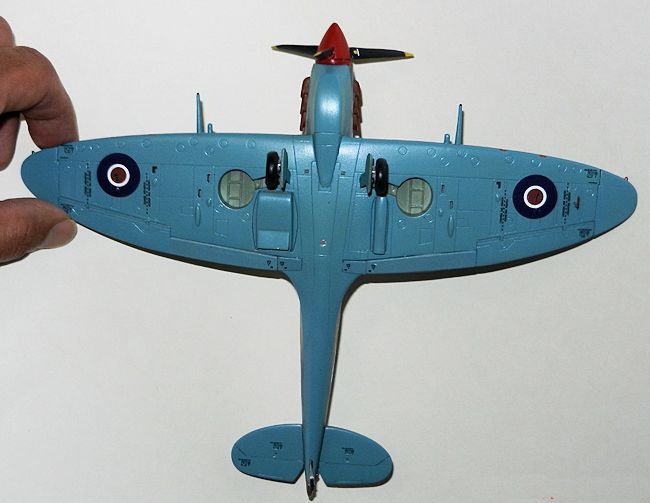 interpretation
or mistakes?) and started with the Dark Earth MM Acryl 4846 and Sand 4711. I
followed the pattern of the Spit cammo and then painted the undersides with a
mix of blue, gray and white to deliver Azure Blue (as the kit was built almost a
year ago I don’t recall exactly how I have achieved this colour). Using the
multiple sources available in Internet (most of them are pure speculation I’d
say) I decided to settle in these two USN colours: ModelMaster Acryl 4847 Navy
Blue Grey and ModelMaster Acryl 4744 Intermediate blue.
interpretation
or mistakes?) and started with the Dark Earth MM Acryl 4846 and Sand 4711. I
followed the pattern of the Spit cammo and then painted the undersides with a
mix of blue, gray and white to deliver Azure Blue (as the kit was built almost a
year ago I don’t recall exactly how I have achieved this colour). Using the
multiple sources available in Internet (most of them are pure speculation I’d
say) I decided to settle in these two USN colours: ModelMaster Acryl 4847 Navy
Blue Grey and ModelMaster Acryl 4744 Intermediate blue.
The only areas left in the original
cammo colours where the rudder and the area underneath the serial numbers in the
fuselage (these were masked with Tamiya tape before the Navy colours were
sprayed)
The same templates I had used to
paint the desert colours were now re attached with rolls of Tamiya tape to spray
very light coats of the above mentioned colours, building depth to a point where
the original sandstone and brown are evident but the main colours now are the
USN ones. One mistake it seems I have made though: these Navy colours seem to
have been applied using the mirrored scheme in which the BR301 had been
originally painted (a detail about this can be seen in the coloured profile of
the instructions from Victory Decals)
The canopy/windshield frames were first pained in black, then desert and
finally USN colours. The propeller hub was painted in red and the blades in
black with yellow tips. With the legs painted and attached I gave the plane
several coats of Future in order to start the
Stencils came from the kit while letters and plane SN are from Victory
decals. They worked really well and reacted with no problem to Set and Sol.
| FINAL CONSTRUCTION |
After applying a coat of semi gloss varnish the last details were added
to the plane.
The only thing left to do was to glue
the main landing gear doors, wheels, antenna and pitot tube, gunsight,
windshield. Exhausts pipes were given a coat of Rust (ModelMaster Acryl) with
the holes painted in black and attached to the fuselage.
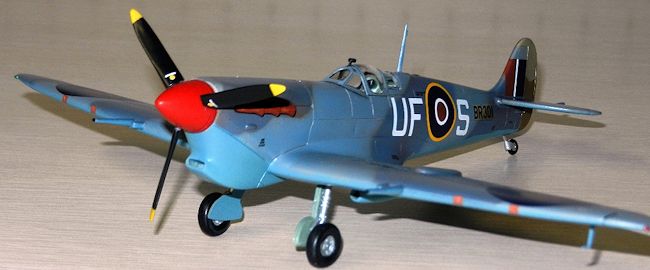 The
position lights were given a drop of light grey, then silver and finally a
couple of drops of clear read and green.
Navigation light on rudder and behind antenna mast were painted with a drop of
grey followed by silver.
The
position lights were given a drop of light grey, then silver and finally a
couple of drops of clear read and green.
Navigation light on rudder and behind antenna mast were painted with a drop of
grey followed by silver.
I learnt at this stage that the
flaps were used all up or all down…and practically there is no picture of a Spit
with flaps down while on the ground. So all the internal work (ribs) of the new
wings is pointless. With some extra work I was able to glue the flaps in the up
position.
The canopy did not sit in place as
it was prevented from touching fuselage by the frame behind the pilot. After dry
fitting and sanding the frame many times (and then giving it a light brush of
Interior Green as now the plastic was showing) I was able to place and glue the
clear part.
Finally the rear mirror was attached to the top of the windshield (black for the structure itself, silver for the mirror).
| CONCLUSIONS |
A kit that shows two different eras
of our hobby (raised and engraved panels) and as such, has trouble making parts
fit properly.
Nevertheless I am quite happy with
the result and I finally can display a Maltese blue Spitifire…and at that the
one flown by the most famous pilot in the Island…and Canadian, eh?
| REFERENCES |
· Spitfires Over Malta (Brian Cull, Frederick Galea)
·
Malta Spitfire (Beurling)
·
Wikipedia
·
Buzz Beurling
· Canadian Aces Home Page
July 2014
If you would like your product reviewed fairly and fairly quickly, please contact the editor or see other details in the Note to Contributors.